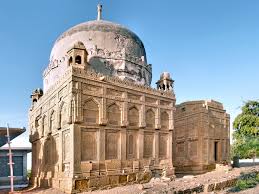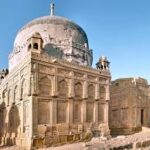Mirpur Khas

Compiled By: Rtn. Gangaram Shamdas Purswani (P.H.F.)
Mirpur Khas (Sindhi and Urdu: meaning “Town of the most-high Mirs“) is the capital city of the Mirpur Khas District and Mirpur Khas Division in the Sindh province, Pakistan. Mirpur Khas is the 7th largest city in Sindh province and the 33rd largest city of Pakistan. According to the 2017 Census of Pakistan, its population is 233,916.[2] Mirpur Khas is known for its mango cultivation, with hundreds of varieties of the fruit produced each year – it is also called the “City of Mangoes,” and has been home to an annual mango festival since 1955.
Lying on the Let Wah Canal at 25°31′39.3″N 69°00′50.6″E, Mirpur Khas is located in the south-eastern quadrant of Sindh. It is located 65 kilometers east of Hyderabad, to which it is connected by Four Lane Dual Carrgiway highway to Hyderabad and by Rail. It is linked to Umerkot by N120 Highway. Karachi is 220 kilometres south-west of Mirpur Khas. The Indian border is located 170 kilometres east of the city.
History
Early
The Mirpur Khas region has been inhabited for millennia, as evidenced by the excavation of the Buddhist-era settlement of Kahoo Jo Daro. The remnants of stupas still remain. In 712 CE, the region was conquered by the armies of Muhammad Bin Qasim.
Founding
The Talpur dynasty conquered Sindh in 1784, and under Mir Fath Ali Khan, Sindh was divided into three smaller regions to be ruled by members of the Talpur family. The three regions were centred around Hyderabad, Khairpur, and Mirpur Khas. The Mankani branch of the family under Mir Ali Murad Talpur inherited the region around Mirpur Khas in 1801, and founded the new city of Mirpur Khas in 1806 to serve as the new capital. Members of Khudabadi Sonara Community residing in Mirpur were called “Mirpuri Bradri” .
Mirpur Khas State
Mir Sher Muhammad Talpur (1829-1843) succeeded Mir Ali Murad, and built a fort in the city when he declared the ruler of the state, and ran a kutchery from within the fort. Elaborate graves for the local rulers were built at Chitorri, and feature a syncretic architectural style that combines elements of Islamic and Rajasthani architecture.
Mirpur Khas remained the capital of the Talpur Mirs of Mirpurkhas until 1843, when Sindh was annexed to British India under the East India Company following the conquest of Sindh by Charles James Napier and defeat of Mir Sher Muhammad Talpur on 24 March 1843 at the battle ground of Dubbo. His battle for the Sindh state earned him the moniker “Lion of Sindh..
British
Later Sindh was made part of the colonial Bombay Presidency and Mirpurkhas was a part of it. Umerkot was made the district’s headquarters town and Mirpur Khas was ignored until the advent of the Luni–Hyderabad branch of the Jodhpur–Bikaner Railway, a subsidiary of the Scinde Railway to the town. The opening of the Jamrao Canal in 1900 made Mirpur Khas stand out of the rest of the towns in the district. It was constituted a municipality in 1901 and was made the district headquarters in 1906.
At the turn of the twentieth century, the population of the town was 2,787 with a density of 82 persons per square mile, however the district, as a whole, saw significant growth in the rise of population from 27,866 (1891) to 37,273 (1901). The cotton produced at Mirpur Khas was considered the best in the country when surveyed and the British exploited the produce by exporting it to other nations.
Modern
After the independence of Pakistan in 1947, because of its proximity with the Indian border, Mirpur Khas became the first city to welcome refugees to Pakistan. It acted as a primary railway junction for the first trains to rail across the Rajasthan to the Sindh province. The Partition of British India resulted in the large-scale exodus of much of the city’s Hindu population, though like much of Sindh, Mirpur Khas did not experience the widespread rioting that occurred in Punjab and Bengal. In all, less than 500 Hindu were killed in all of Sindh between 1947-48 as Sindhi Muslims largely resisted calls to turn against their Hindu neighbours. Hindus did not flee Sindh en masse until riots erupted in Karachi on 6 January 1948, which sowed fear in Sindh’s Hindus despite the fact that the riots were local and regarded Sikh refugees from Punjab seeking refuge in Karachi. Despite the loss of much of the city’s Hindu population, Mirpur Khas District is still an estimated 33% Hindu.
Large numbers of refugees from India began arriving in the city following the Partition of British India – leading to rapid population rises and a shift in demography In 1951, the population was 40,420, of which 68.42% were Urdu-speaking refugees that had fled India – the highest percentage of any major urban area in Sindh. The population rose further to 60,861 in the 1961 census.
Demographics
The people in Mirpur Khas speak Sindhi language and most people also speak Urdu. Over 67% population are Muslims and an estimated 33% are Hindus. In late 18th century, many Muslim families were shifted from east Punjab to the area. The biggest Muslim community who settled here was the Arain community. The Arains from various districts of eastern Punjab such as Amritsar, Gurdaspur, Ferozpur, Ambala, Patiala and Jalandhar moved here and permanently settled. Near Mirpur Khas is a disused Sikh temple named the Gurdwara Pehli Patshahi, built on the site where the founder of Sikhism, Guru Nanak, is traditionally believed to have placed his feet.
Mirpur Khas Railway Station is in middle of city. After 40 years a railway link between Pakistan and India is being opened again. A broad gauge line has been laid from Mirpurkhas to Khokhrapar, which is the border town from Pakistani Side. The new link now connects Karachi (Pakistan) to Jodhpur (India) by the new train service Thar Express. In 2005, work started on converting the metre gauge railway line to Khokhrapar to broad gauge. Mirpurkhas Railway Station has one of the longest platforms in Pakistan.

